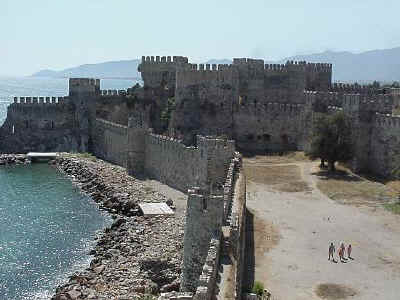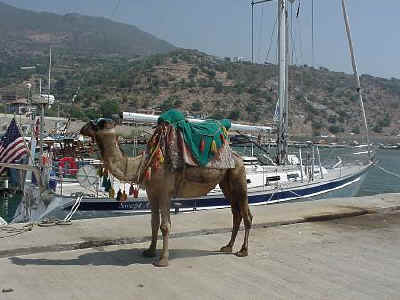 |
 |
 |
| We arrived and cleared into Turkey at Taşucu, the mainland
port for the ferry to Girne in Northern Cyprus. From Taşucu westward, many
of the ports are just fishing villages, with few hotels and tourist
attractions. Aydıncık, shown at left, was once the Hellenistic town of
Kalanderis, and a team of archaeologists was excavating the ruins all around
the small harbor where we were anchored.
This site was an ancient theater. All around it are deeply dug tombs, and nearby were some Byzantine and Ottoman ruins. In the back of the site, a checkerboard of small squares, partitioned with rope webbing, held piles of pottery shards, each waiting for the ceramics expert to reassemble them into pottery. |
|
| Anamur Castle, also called Mamure Kale or
Marble Castle, sits on the coast near the town of Bozyazı. All along the
coast castles like this one dot the landscape. The amount of human effort
that must have gone into building each one is staggering when you see one
after another, in various sizes and states of repair, all along the coast.
This large castle is surrounded on three sides by water, and on the fourth by a moat that is now the home of thousands of small turtles. Its thirty-six towers and crenellated walls come to life as if in a fairy tale. The first fortress on this spot was built by the Romans in the third century AD, but the present structure was built by the Crusaders and was the last refuge of the Lusignan kings of Cyprus. The Karamanoğlu emirs used it in the thirteenth century. The Ottomans expanded the castle and kept it in use until the empire crumbled in 1921. |
 |
 |
The city of Side (pronounced SEE-day) was founded by Aeolian Greeks in the seventh century BC. In the second century BC, Side became a center for slave-trading pirates, and later the Romans took over the slave trade. Side has managed to integrate its extensive ruins, petite harbor, and resort infrastructure in a seamless and charming manner. These remaining columns from second-century temples of Apollo and Athena provide a backdrop for sunset concerts during the summer. The archaeological museum uses the old Roman baths as its rooms and extends its statuary into the pine-scented gardens. The 15,000-seat theater hosts summer events. Mosaics are visible under your feet as you walk along the old city road. |
| We returned to Alanya, one of the stops we'd made earlier in the season with the Eastern Mediterranean Yacht Rally. This unfinished marina served as a fine host for our boats, but most of the time acts as a harbor for local vessels. Instead of our hundred Rally boats in their dress flags, there were only about a dozen small fishing skiffs lining the harbor. During the day, tour boats anchored in the center of the harbor served lunch to their passengers and let them swim in the protected anchorage. Local entrepreneurs then motored out in open boats to sell the hot tourists half-melons filled with ice cream. But a boat like ours was now a local curiosity. Even the camel appeared surprised to see us there. |  |